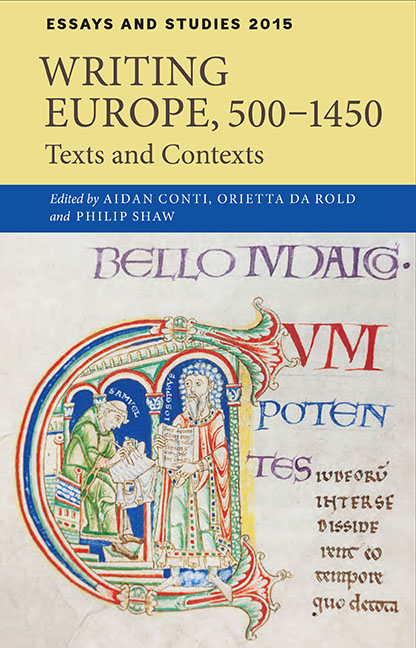Book contents
- Frontmatter
- Contents
- List of Illustrations
- Notes on Contributors
- Preface
- Acknowledgments
- List of Abbreviations
- Medieval Manuscript Studies: A European Perspective
- The DigiPal Project for European Scripts and Decorations
- Italian Giant Bibles: The Circulation and Use of the Book at the Time of the Ecclesiastical Reform in the Eleventh and Twelfth Centuries
- Isolation or Network: Arengas and Colophon Verse in Frisian Manuscripts around 1300
- Writing the Germanic Languages: The Early History of the Digraphs
, and The New Heathens: Anti-Jewish Hostility in Early English LiteratureLatin Composition in Medieval NorwayTranslating Europe in Medieval WalesCharms among the Chants: Verbal Magic in Medieval Bulgarian ManuscriptsIndexThe DigiPal Project for European Scripts and Decorations
Published online by Cambridge University Press: 11 June 2021
Book contents- Frontmatter
- Contents
- List of Illustrations
- Notes on Contributors
- Preface
- Acknowledgments
- List of Abbreviations
- Medieval Manuscript Studies: A European Perspective
- The DigiPal Project for European Scripts and Decorations
- Italian Giant Bibles: The Circulation and Use of the Book at the Time of the Ecclesiastical Reform in the Eleventh and Twelfth Centuries
- Isolation or Network: Arengas and Colophon Verse in Frisian Manuscripts around 1300
- Writing the Germanic Languages: The Early History of the Digraphs , and
- The New Heathens: Anti-Jewish Hostility in Early English Literature
- Latin Composition in Medieval Norway
- Translating Europe in Medieval Wales
- Charms among the Chants: Verbal Magic in Medieval Bulgarian Manuscripts
- Index
Summary
Introduction
PALAEOGRAPHY HAS OFTEN been considered, both by its practitioners and its critics, as something of an art, relying on the expertise of a small number of experienced scholars whose decision-making processes may be difficult or impossible to explain. As David Ganz notes, the consequence of this is that palaeographers are ‘all too often regarded as repositories of authoritative dogma’. Any such system for the transfer of knowledge depends, of course, on a combination of respect and trust, and should either of these waver, there is the potential for the relationship to be resented or to break down. Albert Derolez calls attention to this, observing that the discipline is in crisis due to a lack of transparency:
when an extremely experienced palaeographer declares that a given manuscript was written in Northern France in the first half of the thirteenth century, but fails to indicate the criteria on which this statement is based, he may be a perfect connoisseur, but he is not being an effective teacher. What is more, he unconsciously contributes to the present-day crisis of palaeography as a discipline.
One response to the perception of dependence on a few highly-skilled practitioners has been the development of computer-based methods of palaeography. However, the attendant problem with many such approaches is that they exchange the authority of the palaeographer for the authority of the computer, or so-called ‘black box’. In the hypothetical extreme, operators feed vast quantities of data into a computer and receive ‘answers’ but with little understanding of how these results were achieved, how to interpret them, or whether it is possible to refine the output. Although the reality is more nuanced than this, palaeographers grounded in traditional methodologies have sometimes been reluctant to accept findings from computer-based research even when the advantages of quantitative and statistical approaches seem clear.
With these issues in mind, the project team of the Digital Resource and Database for Palaeography, Manuscripts and Diplomatic (DigiPal) set out to offer a visible and replicable methodology to allow people to explore palaeographical data and to communicate their evidence and accompanying argument to a wider audience. Addressing the needs of both expert palaeographers and those with less specialised teaching and research interests in manuscript studies, DigiPal provides a web-based framework for annotating digital images, interrogating the data, and ordering and presenting the results.
- Type
- Chapter
- Information
- Writing Europe, 500-1450Texts and Contexts, pp. 25 - 58Publisher: Boydell & BrewerPrint publication year: 2015
- 1
- Cited by
Save book to Kindle
To save this book to your Kindle, first ensure coreplatform@cambridge.org is added to your Approved Personal Document E-mail List under your Personal Document Settings on the Manage Your Content and Devices page of your Amazon account. Then enter the ‘name’ part of your Kindle email address below. Find out more about saving to your Kindle.
Note you can select to save to either the @free.kindle.com or @kindle.com variations. ‘@free.kindle.com’ emails are free but can only be saved to your device when it is connected to wi-fi. ‘@kindle.com’ emails can be delivered even when you are not connected to wi-fi, but note that service fees apply.
Find out more about the Kindle Personal Document Service.
- The DigiPal Project for European Scripts and Decorations
-
- Book: Writing Europe, 500-1450
- Online publication: 11 June 2021
×Save book to Dropbox
To save content items to your account, please confirm that you agree to abide by our usage policies. If this is the first time you use this feature, you will be asked to authorise Cambridge Core to connect with your account. Find out more about saving content to Dropbox.
- The DigiPal Project for European Scripts and Decorations
-
- Book: Writing Europe, 500-1450
- Online publication: 11 June 2021
×Save book to Google Drive
To save content items to your account, please confirm that you agree to abide by our usage policies. If this is the first time you use this feature, you will be asked to authorise Cambridge Core to connect with your account. Find out more about saving content to Google Drive.
- The DigiPal Project for European Scripts and Decorations
-
- Book: Writing Europe, 500-1450
- Online publication: 11 June 2021
×



